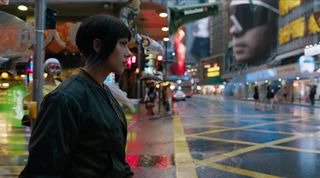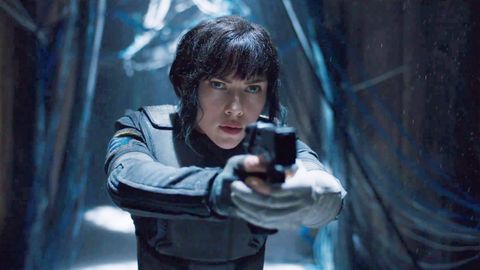GamesRadar+ Verdict
Not the most original film you’ll see this year, but Ghost in the Shell’s visually stunning sci-fi world demands to be seen on the big screen.
Why you can trust GamesRadar+
Ghost in the Shell isn’t the first attempt at adapting anime in live action – Attack on Titan, for example, was released in 2015, and Akira’s red motorcycle has stalled in various levels of development hell for more than a decade – but it’s by far the highest-profile Hollywood attempt. And while it’s not without glitches, the US film has enough flashy sci-fi action and dazzling visuals to suggest it might yet inspire a new wave of anime adaps.
Like Attack on Titan and Akira, Ghost in the Shell is technically adapted from the original manga comic books, but it takes liberal inspiration from the previous anime adaptation, while also drawing on elements from its sequel and TV spin-off. Indeed, the story will be familiar to anyone who saw Mamoru Oshii’s 1995 film.
Security task force Section 9 is a secret government division investigating cybercrime and terrorism. Major (Scarlett Johansson) is a cyborg, with a memory-wiped human brain controlling a wholly artificial body, created by Hanka Robotics.
‘Beat’ Takeshi Kitano (Zatoichi, Hana-bi), in only his third American film, plays Chief Daisuke Aramaki, who oversees the unit, which also includes burly Batou (Game of Thrones’ Pilou Asbæk), sporting the kind of angular blond haircut that wouldn’t look out of place in a 16-bit beat-’em-up. Major and the team are called in when a shady hacker known as Kuze (Michael Pitt) starts targeting Hanka employees.
Ghost 2017 thankfully streamlines some of the more impenetrable elements of the original, becoming easier to follow in the process – no prior knowledge of the franchise is required at the door. The story might be simple, but it remains timely, gesturing to themes of privacy, identity, immigration and terrorism.
Ultimately, it’s just an excuse to enter the jaw-to-the-floor-stunning visual world that’s been created by director Rupert Sanders (Snow White & the Huntsman) and co. It’s the most staggeringly detailed and impressively realised sci-fi location since James Cameron welcomed audiences to Pandora, and one of the few recent blockbusters to benefit from the 3D treatment.

From run-down neon-tinged streets to gleaming corridors and floating holo-ads, the stereoscopy boosts the immersion in the tangible environments. It’s not just the near-future, presumably-near-Tokyo-but-not-specified cityscape that impresses. The gadgetry will also have your eyeballs bulging.
In the pre-credits opening, as Major’s body is created (one of several visual cues directly invoking the anime), she’s surrounded by a phalanx of medical technicians kitted out with vital-sign-measuring holographic visors. It’s one of many neat details (cybernetic enhancements, a scuttling arachnid geisha-bot) that help bring the grimy retro-future metropolis to life.
Johansson wears a “thermo-optical camouflage” skin-suit that can turn her invisible, and it at least provides her with a little more modesty than the anime’s fully nude Major. Most of the (well-staged) action scenes have Johansson at the centre, and she acquits herself admirably in the ass-kicking department, having already proven her abilities as the MCU’s Black Widow.
The casting of a caucasian lead caused a ‘whitewashing’ controversy that’s continued to plague the film, but the narrative does at least provide a reason for the change [withheld for now to prevent spoilers] that may or may not offer some placation.

By necessity of the plot, Major remains a mostly blank slate throughout. It’s a controlled performance by Johansson, who captures the character’s uncanny emptiness, even if the result is that she’s not the easiest central character to root for, even as flashes (or “ghosts”) of her previous life start appearing before her eyes.
As such, the film lacks an emotional anchor, and some of the reveals don’t give the feels like they should. It doesn’t help that the plot is join-the-dots predictable for the most part, even if you’ve not seen the original (or indeed the no-surprises-left-unspoiled trailer). Pitt’s Kuze, for example, feels more effective when he’s skulking in the shadows, and the final showdown would have benefited from more oomph.
If Ghost never feels fully original – you’ll constantly be reminded of other sci-fis besides 1995’s Ghost, and the final voiceover feels cribbed from Batman Begins – it benefits from feeling self-contained, and moves with much more zip than Sanders’ gloomy Snow White. This is a rare blockbuster that doesn’t sacrifice its standalone quality in a bid to build a franchise. Though if this does end up warranting a follow-up, we wouldn’t need any convincing to dive back into this world.

I'm the Editor at Total Film magazine, overseeing the running of the mag, and generally obsessing over all things Nolan, Kubrick and Pixar. Over the past decade I've worked in various roles for TF online and in print, including at GamesRadar+, and you can often hear me nattering on the Inside Total Film podcast. Bucket-list-ticking career highlights have included reporting from the set of Tenet and Avengers: Infinity War, as well as covering Comic-Con, TIFF and the Sundance Film Festival.

